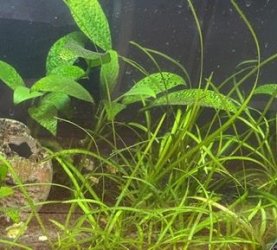Hi, I have 2 20gallon tanks. Both planted and with the soil substrate. I change about 20% of the water every week and test the chemical levels weekly. Nitrite and Ammonia are both 0. Nitrate is about 5-10ppm. Ph is pretty neutral and temp about 78.
One tank has a snail and some ottos in it but I can’t keep the ottos alive. The other has mollies and I’ve lost a few of them pretty soon after buying too . Wondering what I’m doing wrong that my ottos keep dying and my plants all have dark green spots on them (see photo). Any help appreciated!
. Wondering what I’m doing wrong that my ottos keep dying and my plants all have dark green spots on them (see photo). Any help appreciated!
One tank has a snail and some ottos in it but I can’t keep the ottos alive. The other has mollies and I’ve lost a few of them pretty soon after buying too




